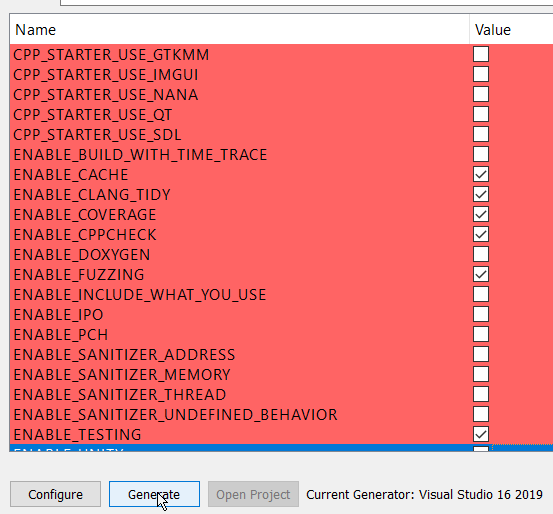## Build Instructions
A full build has different steps:
1) Specifying the compiler using environment variables
2) Configuring the project
3) Building the project
For the subsequent builds, in case you change the source code, you only need to repeat the last step.
### (1) Specify the compiler using environment variables
By default (if you don't set environment variables `CC` and `CXX`), the system default compiler will be used.
Conan and CMake use the environment variables CC and CXX to decide which compiler to use. So to avoid the conflict issues only specify the compilers using these variables.
CMake will detect which compiler was used to build each of the Conan targets. If you build all of your Conan targets with one compiler, and then build your CMake targets with a different compiler, the project may fail to build.
<details>
<summary>Commands for setting the compilers </summary>
- Debian/Ubuntu/MacOS:
Set your desired compiler (`clang`, `gcc`, etc):
- Temporarily (only for the current shell)
Run one of the followings in the terminal:
- clang
CC=clang CXX=clang++
- gcc
CC=gcc CXX=g++
- Permanent:
Open `~/.bashrc` using your text editor:
gedit ~/.bashrc
Add `CC` and `CXX` to point to the compilers:
export CC=clang
export CXX=clang++
Save and close the file.
- Windows:
- Permanent:
Run one of the followings in PowerShell:
- Visual Studio generator and compiler (cl)
[Environment]::SetEnvironmentVariable("CC", "cl.exe", "User")
[Environment]::SetEnvironmentVariable("CXX", "cl.exe", "User")
refreshenv
Set the architecture using [vcvarsall](https://docs.microsoft.com/en-us/cpp/build/building-on-the-command-line?view=vs-2019#vcvarsall-syntax):
vcvarsall.bat x64
- clang
[Environment]::SetEnvironmentVariable("CC", "clang.exe", "User")
[Environment]::SetEnvironmentVariable("CXX", "clang++.exe", "User")
refreshenv
- gcc
[Environment]::SetEnvironmentVariable("CC", "gcc.exe", "User")
[Environment]::SetEnvironmentVariable("CXX", "g++.exe", "User")
refreshenv
- Temporarily (only for the current shell):
$Env:CC="clang.exe"
$Env:CXX="clang++.exe"
</details>
### (2) Configure your build
To configure the project, you could use `cmake`, or `ccmake` or `cmake-gui`. Each of them are explained in the following:
#### (2.a) Configuring via cmake:
With Cmake directly:
cmake -S . -B ./build
Cmake will automatically create the `./build` folder if it does not exist, and it wil configure the project.
Instead, if you have CMake version 3.21+, you can use one of the configuration presets that are listed in the CmakePresets.json file.
cmake . --preset <configure-preset>
cmake --build
#### (2.b) Configuring via ccmake:
With the Cmake Curses Dialog Command Line tool:
ccmake -S . -B ./build
Once `ccmake` has finished setting up, press 'c' to configure the project,
press 'g' to generate, and 'q' to quit.
#### (2.c) Configuring via cmake-gui:
To use the GUI of the cmake:
2.c.1) Open cmake-gui from the project directory:
```
cmake-gui .
```
2.c.2) Set the build directory:

2.c.3) Configure the generator:
In cmake-gui, from the upper menu select `Tools/Configure`.
**Warning**: if you have set `CC` and `CXX` always choose the `use default native compilers` option. This picks `CC` and `CXX`. Don't change the compiler at this stage!
<details>
<summary>Windows - MinGW Makefiles</summary>
Choose MinGW Makefiles as the generator:
<img src="https://user-images.githubusercontent.com/16418197/82769479-616ade80-9dfa-11ea-899e-3a8c31d43032.png" alt="mingw">
</details>
<details>
<summary>Windows - Visual Studio generator and compiler</summary>
You should have already set `C` and `CXX` to `cl.exe`.
Choose "Visual Studio 16 2019" as the generator:
<img src="https://user-images.githubusercontent.com/16418197/82524696-32502680-9af5-11ea-9697-a42000e900a6.jpg" alt="default_vs">
</details>
<details>
<summary>Windows - Visual Studio generator and Clang Compiler</summary>
You should have already set `C` and `CXX` to `clang.exe` and `clang++.exe`.
Choose "Visual Studio 16 2019" as the generator. To tell Visual studio to use `clang-cl.exe`:
- If you use the LLVM that is shipped with Visual Studio: write `ClangCl` under "optional toolset to use".
<img src="https://user-images.githubusercontent.com/16418197/82781142-ae60ac00-9e1e-11ea-8c77-222b005a8f7e.png" alt="visual_studio">
- If you use an external LLVM: write [`LLVM_v142`](https://github.com/zufuliu/llvm-utils#llvm-for-visual-studio-2017-and-2019)
under "optional toolset to use".
<img src="https://user-images.githubusercontent.com/16418197/82769558-b3136900-9dfa-11ea-9f73-02ab8f9b0ca4.png" alt="visual_studio">
</details>
<br/>
2.c.4) Choose the Cmake options and then generate:

### (3) Build the project
Once you have selected all the options you would like to use, you can build the
project (all targets):
cmake --build ./build
For Visual Studio, give the build configuration (Release, RelWithDeb, Debug, etc) like the following:
cmake --build ./build -- /p:configuration=Release
### Running the tests
You can use the `ctest` command run the tests.
```shell
cd ./build
ctest -C Debug
cd ../
```